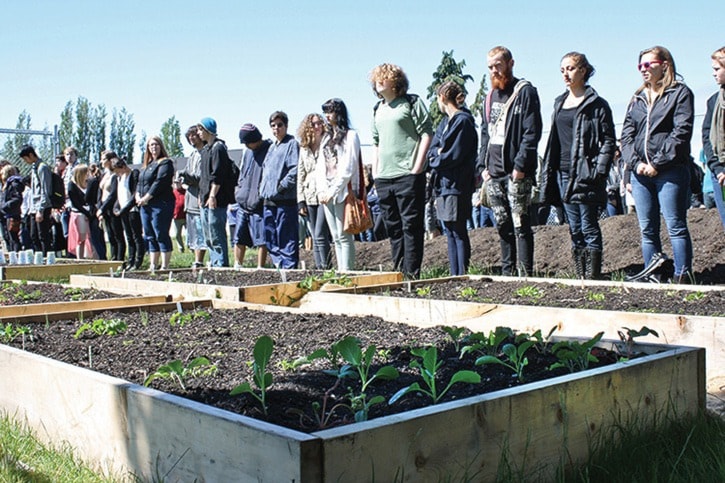A mound of good, black soil lays between two rows of rectangular garden boxes in a fenced-off section of unused playing field at Victoria High School.
Students and staff stand in two lines facing the sun, as per the instructions of the First Nations elders who are here to officially bless the gardens and the plants that have begun to sprout up from the soil. The sun, emerging almost on cue for the ceremony, represents the dawning of a new day and the promise of good things to come.
That is the message and the lesson on this day, that students can, if they put their mind to it, produce good, healthy food for themselves and their families.
Teacher Jim Pine recalls the eye-opening experience of a young student from a previous year. Pine’s comparative civilization class was visiting an aquaponic farm near the school and students were working in the dirt.
“She accidentally pulled up a tiny carrot and said, ‘I didn’t know that’s where they came from!’” Pine says.
Such revelations, while incredulous to some, might be expected he said, “if the only place you’ve seen carrots is in a plastic bag at Thrifty’s.”
Students participating in the garden project are in Pine’s environmental sustainability 11 class and Andrea Hart’s science and technology 12 class.
Pine makes it a point to teach students where everyday items such as water, electricity, and food come from. In having students create and tend to this garden and get their hands dirty, he says, “we hope to show a direct relationship between the work they do and the way things grow.”
Grade 11 student Ricky Adams likes the fact the gardens will provide a good source of organic produce.
“There’s so many different places that put chemicals in the food these days,” he says, standing next to his class’s planted rows of cabbage and cilantro.
Adams’ Grade 12 schoolmate Leroy Bell, whose mother took part in the First Nations blessing of the plots, took a more holistic view of the project: “We’ve been taking a lot of resources (from the land). It’s about time we gave back to the earth.”
Hart, who also teaches Grade 9 science, says students may learn the names on the periodic table of the elements, but it’s good that they learn how certain elements combine in fruits or vegetables, for example.
“The big idea (with the project) is environmental sustainability, creating awareness of what that is and what we can do about it,” she says.
Vic High had a large, productive garden on the school grounds when the original building was erected 100 years ago. At the time, rural sciences were part of the curriculum and the produce was distributed to students and around the neighbourhood.
Vic High principal Randi Falls says the new garden is a good example of project-based learning.
“We wanted to provide students with the opportunity to solve problems and work co-operatively in a meaningful and tangible way,” she says, noting the project brings the school full circle from the time the original garden was planted.
First Nations elders who gave their spiritual blessing to the garden spoke of the students going back to the basics by growing their own food, taking care of the Earth and each other.
Esquimalt Nation elder Mary Anne Thomas called the students “beautiful flowers” who have grown, just like the plants that will gradually spring up on this site.
•••
Local merchants got on board for Vic High’s garden project.
Denis Madsen, owner of Tower Fence, told an enquiring student that he grew up on Gladstone Street, steps away from the site. He was looking for a way to give something back to the community and donated the fencing and labour – more than requested – that protects the gardens.
Among other donors, and there were many, Vic West Rona offered up all of the wood for building the raised beds and Ellice Recycling provided the rich soil.
Students in Jim Pine and Andrea Hart’s classes, as well as the school’s garden club, will help maintain the beds until school lets out next month. Through the summer, volunteers from the Greater Victoria Compost Education Centre, next door on Chambers Street, will regularly look after the plants and the harvesting.
